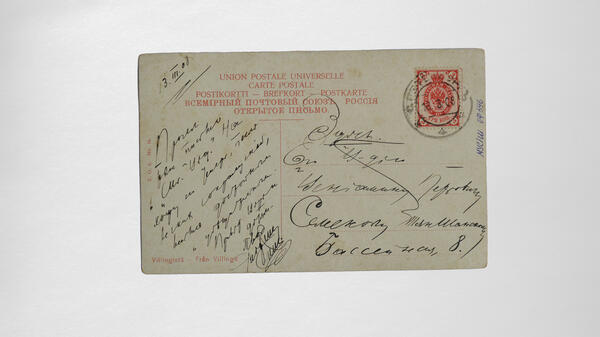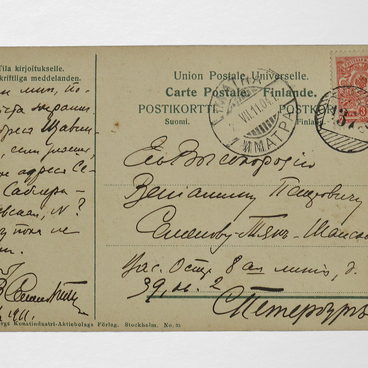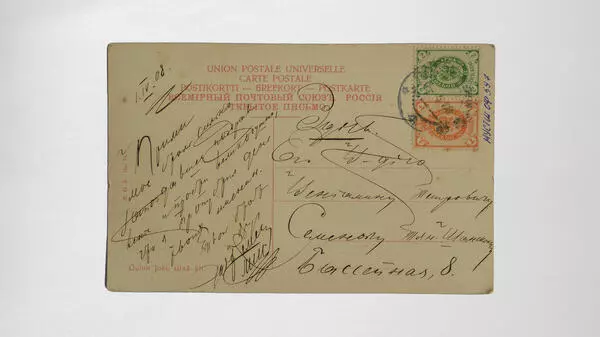The brothers Andrey and Veniamin Semyonov-Tyan-Shansky were in constant correspondence throughout their lives. A significant part of it has been preserved in the family archive of the descendants of Veniamin Petrovich in St. Petersburg. The museum collection contains a postcard depicting a view of northern nature with a short text on the back: ‘I have read your letter in “St. Petersburg Vedomosti”, now I find this paper, after some slight abridgements, very dignified and convincing. Give my love to Vera and children. Your Andrey STSh. To His Highness Veniamin Petrovich Semyonov-Tyan-Shansky. Basseinaya Street, 8’.
Veniamin Semyonov-Tyan-Shansky (1870-1942) was a statistician and geographer. He was the author of fundamental works on urban and rural settlements. From when he was a child, his father inspired in him an interest in geography, the study of nature and society. In 1895-1897, Veniamin Petrovich took part in the first all-Russian population census as s secretary of the Main Census Commission. Afterwards he worked in the Central Statistical Committee and in the statistics department of the Ministry of Finance, and from 1905 up to 1917, he was the head of the statistics department in the Ministry of Trade and Industry.
It was he who created and edited the multivolume work ‘Russia. Complete Geographical Description of Our Fatherland’. Moreover, Veniamin Semyonov-Tyan-Shansky published the series ‘Trade and Industry of European Russia’, which was awarded the Grand Prix at the international exhibition in Turin; and he received the Academy of Sciences prize for the work ‘City and Village in European Russia’.
From 1918 he was engaged in teaching: he was a professor at the Pedagogical Institute, and then at the Leningrad University. He also was the initiator and director of the Central Geographical Museum, which became the third largest in Leningrad, after the Hermitage and the Russian Museum. An important part of his life was dedicated to the local history movement in the 1920s. He was a member of the Presidium of the Central Bureau of Local History and played an active role in the Russian Geographical Society. Veniamin Semyonov-Tyan-Shansky died in besieged Leningrad on February 8, 1942, having refused to be evacuated.
Veniamin Semyonov-Tyan-Shansky (1870-1942) was a statistician and geographer. He was the author of fundamental works on urban and rural settlements. From when he was a child, his father inspired in him an interest in geography, the study of nature and society. In 1895-1897, Veniamin Petrovich took part in the first all-Russian population census as s secretary of the Main Census Commission. Afterwards he worked in the Central Statistical Committee and in the statistics department of the Ministry of Finance, and from 1905 up to 1917, he was the head of the statistics department in the Ministry of Trade and Industry.
It was he who created and edited the multivolume work ‘Russia. Complete Geographical Description of Our Fatherland’. Moreover, Veniamin Semyonov-Tyan-Shansky published the series ‘Trade and Industry of European Russia’, which was awarded the Grand Prix at the international exhibition in Turin; and he received the Academy of Sciences prize for the work ‘City and Village in European Russia’.
From 1918 he was engaged in teaching: he was a professor at the Pedagogical Institute, and then at the Leningrad University. He also was the initiator and director of the Central Geographical Museum, which became the third largest in Leningrad, after the Hermitage and the Russian Museum. An important part of his life was dedicated to the local history movement in the 1920s. He was a member of the Presidium of the Central Bureau of Local History and played an active role in the Russian Geographical Society. Veniamin Semyonov-Tyan-Shansky died in besieged Leningrad on February 8, 1942, having refused to be evacuated.





